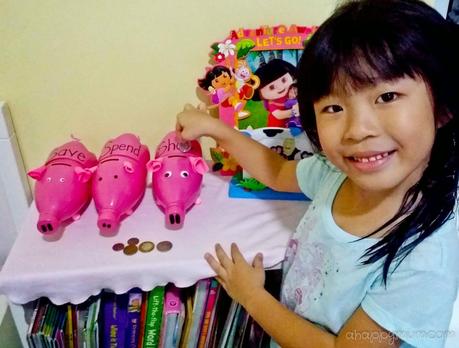Now that I am a mum, I realize that while it might be easy for me to teach etiquette and safety, when it comes to money matters, it can be a daunting task thinking of where, when and how to start teaching my children. Reports have shown that children as young as three are able to grasp basic financial concepts like value, exchange and choice and most children's financial habits are formed by the age of seven. Do I hear a gasp? Since my big girl is turning seven next year and will be attending primary school where she starts receiving a daily allowance, the start of 2015 is time for me to teach her about the value of money and start instilling a love for saving.
So how do you teach your children to be financially astute from a young age? Today, I'm sharing with you 12 ways you can teach your child to save.

1) Make saving fun and meaningful
Savings should never be seen as a chore to a child. In as many ways as possible, parents should make it a fun and meaningful affair. To motivate my girl to save and make our piggy banks one-of-a-kind, we decided to create our own out of recycled material (for the DIY tutorial, read my Creativity 521 post here). Instead of just one, we made three little pigs - Spend pig is for occasional small treats like sweets or stickers, Save pig is for an expensive item or to be deposited in the bank, and Share pig is used for donating to a cause, helping someone in need or buying gifts for others. So far, it has been working very well for us and I have also started giving Angel some coins regularly to let her think of how she wants to use her money. Guess which pig she chose first? To my surprise, she chose to Share.
2) Talk about money
Children should understand that money is finite and hard-earned. Talking about money can happen anytime and anywhere in a casual manner. Since Angel was a toddler, I would explain to her that money does not fall from the sky or comes out of the machine by magic, in fact, everything comes at a cost. I also encourage her to save water and electricity because these cost money too. Now that she is better able to understand numbers and concepts, we would look at prices and talk about how expensive or cheap the things are when we go window shopping.
3) Set long-term goals
As an incentive to save, I asked her to come up with a wish list of the things she would like to receive at the end of a six-month period. For instance, it could be an expensive Frozen bag or a trip to Legoland. In order to fulfill these wishes, she would need to make effort on her part and save up more before she can enjoy the fruit of her labor. You can pin up the wish list or pictures of the things you child wants to better remind and encourage him/her too.

4) Open a savings account
After Angel turned three and we returned from Sweden, one of the first things I did was to set up a savings account for her. Even though it might initially contain only her red packet money from Chinese New Year or birthday, the important thing was that from then onwards, she began to understand how a bank functions, how money need not be spent right away but can be saved up to accumulate more interest in the long run.
5) Differentiate between needs and wants
When we are at the store and she sees something she likes, I will ask her "Is this something you need? Or is it something you want?" Then I will explain to her the difference between the two. She might be only five now but I know she is big enough to justify spending decisions and sensible enough to distinguish between necessities and desires. It is also important to set a priority list so that you know the most important things you need to purchase at the moment and not give in to other temptation.
6) Make them work for money
Being a stay-at-home mom means that I get ample opportunity to let the kids help out with the household chores. As the big sister, Angel is now capable of many tasks including vacuuming the floor, cleaning the table, keeping the laundry, helping to cook and so on. On days that I feel she has done an outstanding job, I will give her a token sum of fifty cents to a dollar as a reward. This helps her to further understand the fact that money has to be earned through hard work.
7) Understand delayed gratification
This is likely one of the most important concepts a child needs to learn. Delayed gratification means that you can reject a smaller, immediate reward so as to receive a bigger and more lasting reward in future. For a start, as the parent, I learn to say "No" and not give in to every whine or request from the kids when they want to buy something on impulse. To make it easier for them to comprehend, I will explain the cost in another context for instance "This toy costs $10 which will be able to buy us 4 bowls of your favorite fishball noodles". For now, both the kids know jolly well that they are not allowed to demand for toys or treats when we go out and they learn to wait so as to enjoy better things next time.

8) Make financial decisions together
Nowadays, I try to let Angel make spending decisions with me when we are buying groceries at the supermarket. We will take a look at the price tags, compare them and based on what we need and what is more value for money, we decide on what to buy. I also let her take charge of paying at the cashier and receiving the change, which really makes her feel like a tiny grown up.
9) Offer rewards
On weekends, if I deem that Angel has put in enough effort to save up for that week, I will give her a small treat like a sweet, ice cream or a sticker. Of course, she can choose to reject all of them and take the money instead. That seldom happens for now. Other than that, I also plan to come up with a matching contribution system and for every $10 saved, she will receive an additional $2 from us. Yes, dollar-for-dollar is not very practical in my view but 20% is not too bad, right?
10) Let them make mistakes
As parents, one of the best ways to teach our children is to let them learn from mistakes. The same applies when teaching them about the value of money. So, I do give Angel the liberty to make her own decisions in spending her own money. On occasions when for instance, she chooses an inferior quality product that lasts for barely a week or uses up her money at the arcade so that she is unable to get a new set of crayons, I then take the opportunity to educate her about the importance of spending wisely.

11) Learn through play
For young children, one of the best ways to learn is through games. Thanks to the husband, we have quite a handful of board games stashed away in our house and we have begun playing some of them with Angel. I find that games like Monopoly and Game of Life can be useful in teaching her to spend wisely and manage her finance, whereas playing cashier games using real notes and coins can let her learn to count and give her a realistic view of the world we live in.
12) Be a role model
Like I said, my mom was the best person for me to look up to and it's now time for me to set a good example for my children too. The hubby and I might like to take the family on vacations but other than that, we are quite prudent with our finances and do not splurge or spend on unnecessary goods. We also make sure that we put money in our own coin banks regularly in the hope that our kids will learn about the importance of saving too.
******
 Based on a POSB National Savings Survey, the results showed that 89% of the participants felt that the value of savings has eroded amongst children these days. Though it is the primary responsibility of parents to teach children about the importance of thrift, in order to reignite the habit of saving among children, POSB - with support from the MOE - will be bringing back the National School Savings Campaign 2015 which was first introduced in 1969.
Based on a POSB National Savings Survey, the results showed that 89% of the participants felt that the value of savings has eroded amongst children these days. Though it is the primary responsibility of parents to teach children about the importance of thrift, in order to reignite the habit of saving among children, POSB - with support from the MOE - will be bringing back the National School Savings Campaign 2015 which was first introduced in 1969.Using the savings stamp card as a tool to save, each primary school student can get their POSB National School Savings stamp card from any POSB/DBS branch, SingPost outlet and at Pacific or Popular bookstores in schools from 2 February 2015 onwards. Stamps costing $0.50 each will be sold will be sold at Pacific or Popular school bookstores and at SingPost outlets. Upon completion of 20 stamps, the student can drop the stamp card into any POSB/DBS Quick Cheque Deposit location which will credit the full value of the stamp card ($10) and a $1 bonus (the bonus is limited to one stamp card per child, per month and only valid for POSBkids account holders. Sign up here for an ePOSBkids account if your child doesn’t have one).
As parents, we can pledge our support and find out more about this campaign here and encourage non-participating schools to join the campaign.
Remember, parents are the biggest influencers and it's never too early to start teaching our children about the importance of saving. So, why not start today?
Disclosure: This is a sponsored conversation between POSB and A Happy Mum. All opinions, tips and experiences are my own.

